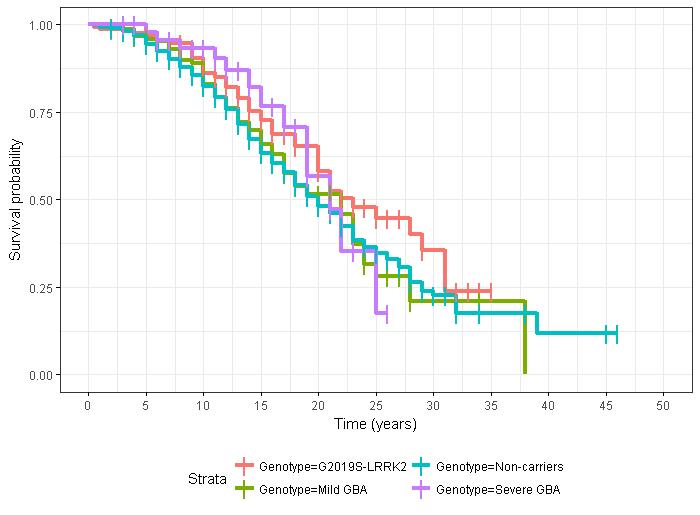Session Information
Date: Monday, October 8, 2018
Session Title: Parkinson's Disease: Genetics
Session Time: 1:15pm-2:45pm
Location: Hall 3FG
Objective: To assess the impact of common genetic mutations on Parkinson’s disease survival.
Background: The prognosis of Parkinson’s disease (PD) is heterogeneous with many factors influencing disease severity and mortality. The G2019S mutation in the LRRK2 gene generates a mild PD phenotype while mutations in the GBA gene are considered to result in a worse PD phenotype, genetic based survival studies are lacking.
Methods: Patients with PD were screened for the G2019S mutation in the LRRK2 gene and the seven most common Ashkenazi Jewish GBA mutations which were classified as mild (N370S or R496H) or severe (L444P, c.84insG, IVS2+1G->A, V394L or 370Rec) (mGBA, sGBA respectively) and underwent comprehensive medical and neurological assessments. Disease onset and date of death were ascertained, with mortality rates calculated for each group of patients. Kaplan Meier survival curves were calculated, stratified by genotype, using the Yung & Prentis adjusted log-rank test, comparing each group of genetic PD patients to idiopathic PD patients (iPD) with a Benjamini-Hochberg (BH) multiplicity correction for FDR control at a 0.1 significance level. A multivariate analysis fitted the best Cox proportional hazards model based on backward stepwise Alkaike Information Criterion (AIC).
Results: 1086 idiopathic PD patients (380 died), 159 LRRK2-PD (49 died), 148 mGBA-PD (56 died) and 49 sGBA-PD (13 died) participated in this study (Table 1 A). The average life expectancy for Israeli males and females in 2016 was 80.7 yrs and 84.2 respectively. Both female and male PD patients had significantly lower mean life expectancy (Female mean: 79.23, BH adjusted p-value <0.001; Male mean: 77.85; BH adjusted p-value <0.001). However, LRRK2-PD men (79.73 yrs) and sGBA-PD men (78.22 yrs) did not have significantly lower life expectancy compared to the Israeli registry (Table 1B). Univariate analysis using the Yung & Prentis adjusted log-rank test indicating better survival rates for LRRK2-PD (Figure 1). Multivariate analysis detected significant prediction value for age at onset (higher age of onset increasing hazard probability) and female gender (longer life expectancy compared with males) (HR: 1.17, BH adjusted p-value <0.001, HR: 0.4, BH adjusted p-value: 0.027,respectively).
Conclusions: LRRK2-PD patients have longer survival periods compared with iPD and GBA-PD as assessed by mortality ratios. This reinforces the notion that LRRK2-PD has a milder phenotype compared with both iPD and GBA-PD.
To cite this abstract in AMA style:
A. Thaler, T. Kozlovski, T. Gurevich, A. Bar Shira, M. Gana-Weisz, A. Orr-Urtreger, L. Goldstein, N. Giladi, A. Mirelman. Survival of patients with Parkinson’s disease is influenced by the mutations in the LRRK2 but not GBA gene [abstract]. Mov Disord. 2018; 33 (suppl 2). https://www.mdsabstracts.org/abstract/survival-of-patients-with-parkinsons-disease-is-influenced-by-the-mutations-in-the-lrrk2-but-not-gba-gene/. Accessed December 4, 2025.« Back to 2018 International Congress
MDS Abstracts - https://www.mdsabstracts.org/abstract/survival-of-patients-with-parkinsons-disease-is-influenced-by-the-mutations-in-the-lrrk2-but-not-gba-gene/


